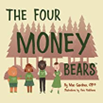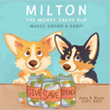July 19, 2024
5 Things Your Pre-K through 2nd Grader Can Learn About Money
Personal finance can seem like a mature and “adult” topic, but there is a consensus amongst experts that children have most of their financial habits formed by the age of seven.
The ability to manage money well will have a significant effect on one’s wellbeing throughout life, making it a great topic to include in family discussions. Here are a few suggestions to help you provide some beneficial early money lessons for young people in your life.
- Coin and Bill Identification: The first step to understanding the foundation of money is being able to identify different currency amounts. Many of us began our personal finance journey by playing memory games to identify coins and counting out different values of coins to make a dollar. This is a great example of using games to engage younger children in learning about the value of money. The next time you need to make a cash transaction, let your little one help identify the various types of bills and coins that you will be using.
Savings: This is one of the most important aspects of finance to teach young children. Whether this is done in the form of a piggy bank, “Good Behavior Jar”, or earning rewards towards a toy, it is important for younger children to understand the value of “working” for a reward. In the era of ApplePay® and Venmo®, the concept of payment to young children can feel fake as they do not see the immediate transference of cash. If your child receives money from the tooth fairy, grandma and grandpa, or a birthday gift, this could be a great opportunity to teach your little one that they can hold onto the money and save it to get something bigger later on, this also illustrates delayed gratification of rewards, and can foster feelings of pride and accomplishment over being able to buy something with their own money. Even in day-to-day transactions, saving around 10% of total earnings is always a good idea.
 Suggested read: The Four Money Bears by Mac Gardner follows Savings Bear, Investor Bear, Giving Bear, and Spending Bear on their journey to learn about personal finance!
Suggested read: The Four Money Bears by Mac Gardner follows Savings Bear, Investor Bear, Giving Bear, and Spending Bear on their journey to learn about personal finance!
Wants vs. Needs: This is a concept even adults can struggle with. Having your child identify if something they want is a need or not can help them understand whether they want to spend their hard-earned money on something they may not use for more than a day. A great way to explain this concept is in the grocery store. When your child reaches for a colorful box of cereal, a candy bar, or a toy in a display case, ask if this is something they truly need. Needs are things that we cannot live without such as healthy foods, clean clothes, and a place to live. Whereas wants are things that we can live without.
 Suggested read: Milton the Money Savvy Pup by Jamie Bosse: a fun kid's book series that follows Corgi pup Milton as he learns about money!
Suggested read: Milton the Money Savvy Pup by Jamie Bosse: a fun kid's book series that follows Corgi pup Milton as he learns about money!
- Rewards: When you were a small child, your parents may have gifted you a piggy bank to store any money that acquired through doing small tasks. Assigning your child age-appropriate chores like picking up toys, being nice to their siblings, or sitting quietly, can make them feel as if they have a sense of ownership over the rewards they get, while simultaneously encouraging positive behaviors. Children are also likely to make different spending decisions with their own money than with money given to them.
- Play!: One of the best and most effective ways for young children is through play. Whether playing pretend store, restaurant, or ice cream parlor, these imagined scenarios are perfect for demonstrating the process of a transaction at the simplest level. Young kids learn from observing the world around them, and gameplay is a perfect way to mirror personal finance skills at an introductory level.

